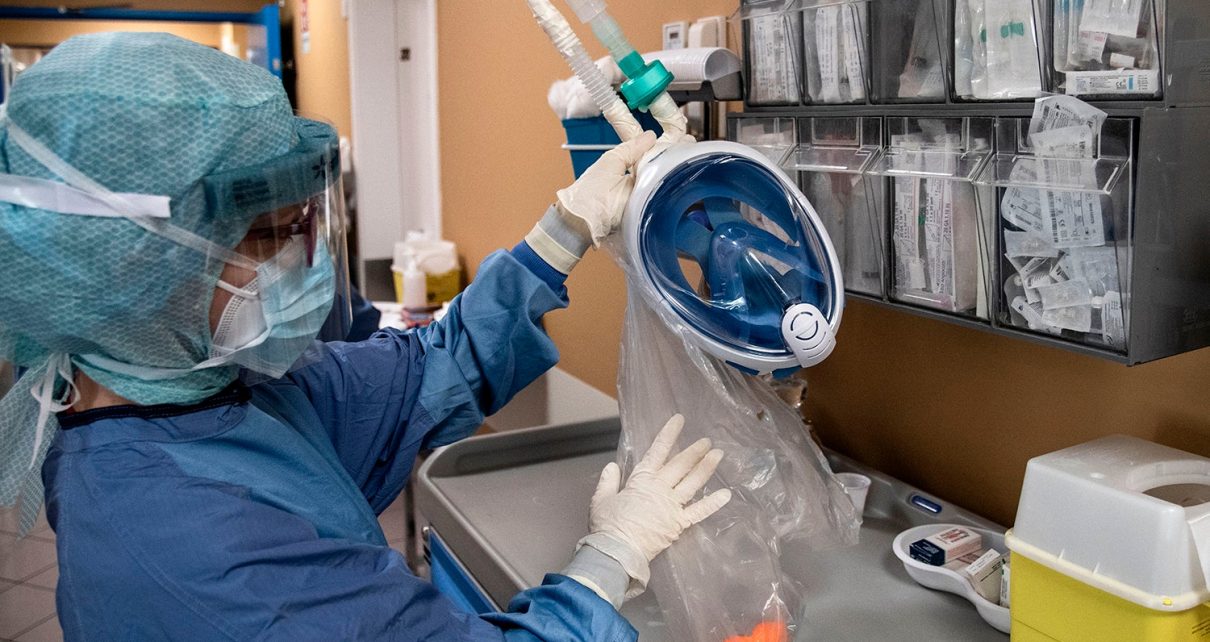Last month Spanish authorities put out an urgent call for donations of snorkeling masks to build improvised devices to help COVID-19 patients breathe. Shortages of ventilators, which push air into failing lung, have inspired members of maker culture worldwide.
Innovation has continued as the shape of the pandemic has shifted. In addition to addressing the demand for standard ventilators, a mask-based approach provides a potentially more benign form of breathing assistance than invasive ventilation, which involves intubation: inserting a tube into the trachea.
The Italian company Isinnova made its solution—a 3-D-printed valve attached to a snorkeling mask—freely available. The valve connects the mask to a noninvasive ventilator, similar to machines used to treat sleep apnea. These tweaked masks offer several advantages for both patients and clinicians navigating the specific threats of COVID-19, including delaying or avoiding intubation in some cases.
In Colorado, an interconnected web of makers, engineers and clinicians have been working from the original Italian design to create mask-valve combinations to use with noninvasive ventilation. Aaron Brown, an associate professor of mechanical engineering at Metropolitan State University of Denver, is using an outsize 3-D printer to make 50 attachments a week. “The idea,” he says, “is that these can free up patients who are not critical,” leaving the infamously short supply of invasive ventilators for the most critical cases.
Gary Grant, who directs a maker lab at Vail Mountain School, an independent K–12 school in Colorado, has adjusted the original Italian apparatus to fit specific snorkeling masks from different manufacturers. “It’s been the most exciting and meaningful project I’ve worked on in my entire life,” says Grant, who once worked as a biomedical engineer.
The general design of the device solves three COVID-19–specific issues with noninvasive ventilation, which has long been a mainstay in hospitals. One problem is the risk that health care personnel will be exposed to virus particles exhaled from the lungs. The structure of the tweaked mask ensures “zero leak,” says Lisa Hile, an emergency medicine physician at hospitals in Glenwood Springs, Colo., and Vail, Colo., who originally got in touch with Grant about solving the problem.
In addition to this safety feature, the placement of the valve at the top of the mask instead of the front means that patients wearing it can be placed on their stomachs, or “proned.” Some specialists are arguing that proning should be done as early as possible in patients with COVID-19
Hile and her co-workers hope to use the mask-valve combo as an alternative to invasive ventilation—the end stage of oxygen therapy that patients with the most severe forms of the disease may confront. “There is a big thing with acute respiratory distress syndrome, or ARDS, where we prone people on a vent. And everyone has started to do that with vented patients with COVID-19,” Hile says. “But what we’re finding is that if you can prone people awake,” as opposed to under the sedation necessary for invasive ventilation, “they’re actually doing much better.” These nonintubated patients, Hile says, can still speak and tell health care workers how they are feeling.
The standard route for oxygen support in a struggling patient involves escalation through increasingly forceful and ultimately invasive methods, and the new apparatus may help slow the transition through these intensifying steps. The first intervention that a patient may encounter is receiving oxygen through a cannula in the nose, says James Gunsalus, a respiratory therapy supervisor specializing in adult critical care. If that relatively light flow does not do the trick, and the patient’s blood oxygen saturation remains low, then treatment is bumped up to a mask that floods the lungs with 100 percent oxygen with every inhalation.
What happens next remains a point of debate in COVID-19 management. Clinicians are trying to decide whether patients should be placed on high-flow nasal cannula oxygen, which adds heated, humidified air to the mix. Or they may opt for ventilation either with mask-based noninvasive positive-pressure airway pressure or with invasive intubation
Some health professionals contend that timely invasive ventilation, which requires intubation, is essential to get oxygen saturation back to reasonable levels. The idea is that this Hail Mary intervention should start as soon as possible, before a downward momentum becomes overwhelming.
But being intubated can be an ominous turning point. The outcome becomes increasingly bleak the more time a person spends on invasive ventilation. In these cases, mortality becomes much higher, Hile says. “People with COVID-19 are on these vents for a long time, and mortality is very high,” she says. For that reason, she and other clinicians reason that putting a patient on a kinder, gentler version of ventilation—proning and using a mask with a valve and positive airway pressure instead of a tube down the throat—for a while might buy that individual time and avoid or diminish the intubation period.
Indeed, the top-valve snorkeling mask has been tried for this purpose at one of the hospitals where Hile works. After several test runs with health care professionals for fit and to confirm that people could be proned while wearing the device, the team fitted it to a patient with COVID-19. Hile followed up a day later with a text: “The mask is working!”
But that success involved just one patient. Not everyone is ready to embrace the technology yet. Gunsalus says that the window of time when such a mask might work can vary, as can which patients are a good candidate for it. An older person with dementia, for example, might find the tight, face-covering mask confusing and try to yank it off, which would aerosolize virus into the room. The intervention might be good for some people, he says, but “the trick is knowing who it’s good for.”
Read more about the coronavirus outbreak here.



